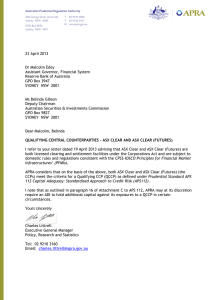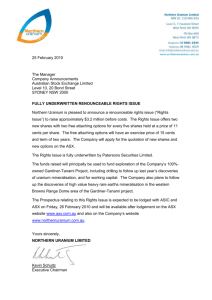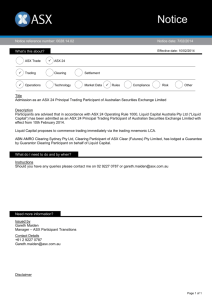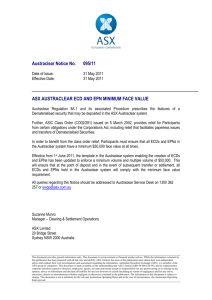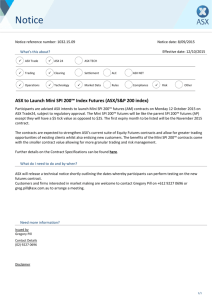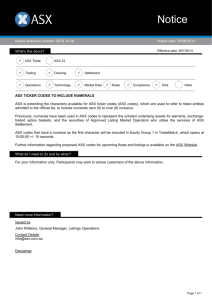oversight of Clearing and Settlement Facilities overview
advertisement
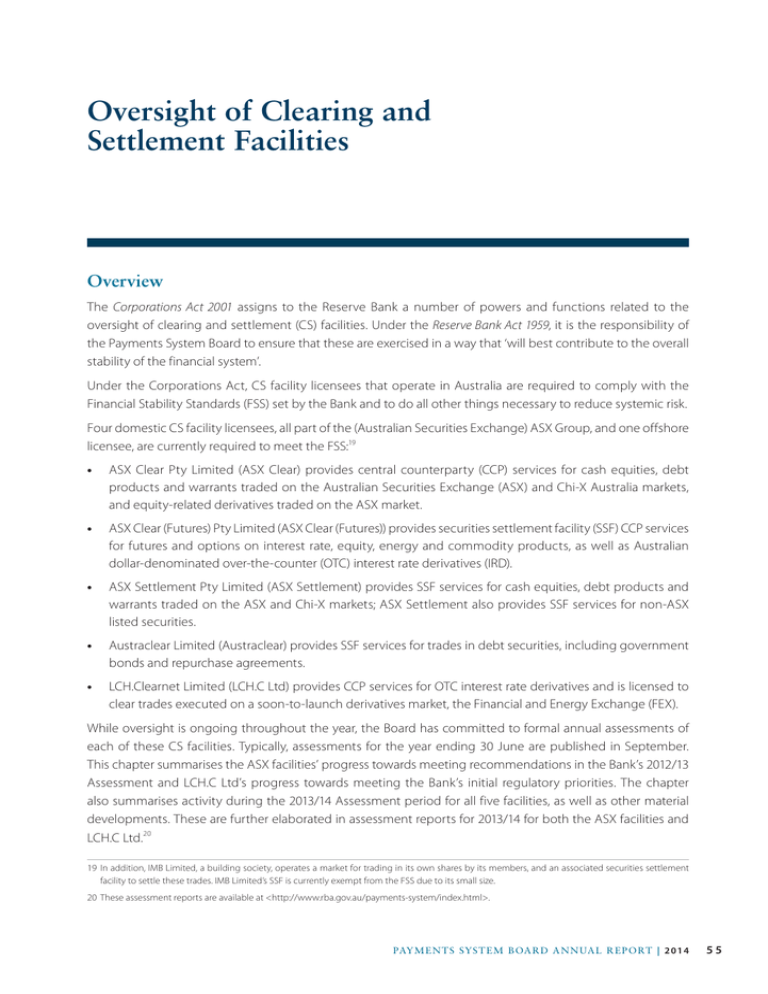
Oversight of Clearing and Settlement Facilities Overview The Corporations Act 2001 assigns to the Reserve Bank a number of powers and functions related to the oversight of clearing and settlement (CS) facilities. Under the Reserve Bank Act 1959, it is the responsibility of the Payments System Board to ensure that these are exercised in a way that ‘will best contribute to the overall stability of the financial system’. Under the Corporations Act, CS facility licensees that operate in Australia are required to comply with the Financial Stability Standards (FSS) set by the Bank and to do all other things necessary to reduce systemic risk. Four domestic CS facility licensees, all part of the (Australian Securities Exchange) ASX Group, and one offshore licensee, are currently required to meet the FSS:19 •• ASX Clear Pty Limited (ASX Clear) provides central counterparty (CCP) services for cash equities, debt products and warrants traded on the Australian Securities Exchange (ASX) and Chi-X Australia markets, and equity-related derivatives traded on the ASX market. •• ASX Clear (Futures) Pty Limited (ASX Clear (Futures)) provides securities settlement facility (SSF) CCP services for futures and options on interest rate, equity, energy and commodity products, as well as Australian dollar-denominated over-the-counter (OTC) interest rate derivatives (IRD). •• ASX Settlement Pty Limited (ASX Settlement) provides SSF services for cash equities, debt products and warrants traded on the ASX and Chi-X markets; ASX Settlement also provides SSF services for non-ASX listed securities. •• Austraclear Limited (Austraclear) provides SSF services for trades in debt securities, including government bonds and repurchase agreements. •• LCH.Clearnet Limited (LCH.C Ltd) provides CCP services for OTC interest rate derivatives and is licensed to clear trades executed on a soon-to-launch derivatives market, the Financial and Energy Exchange (FEX). While oversight is ongoing throughout the year, the Board has committed to formal annual assessments of each of these CS facilities. Typically, assessments for the year ending 30 June are published in September. This chapter summarises the ASX facilities’ progress towards meeting recommendations in the Bank’s 2012/13 Assessment and LCH.C Ltd’s progress towards meeting the Bank’s initial regulatory priorities. The chapter also summarises activity during the 2013/14 Assessment period for all five facilities, as well as other material developments. These are further elaborated in assessment reports for 2013/14 for both the ASX facilities and LCH.C Ltd.20 19In addition, IMB Limited, a building society, operates a market for trading in its own shares by its members, and an associated securities settlement facility to settle these trades. IMB Limited’s SSF is currently exempt from the FSS due to its small size. 20 These assessment reports are available at <http://www.rba.gov.au/payments-system/index.html>. PAY ME N Ts SYSTE M B oar d AN N UAL Repo rt | 2 0 1 4 55 FMI Oversight Committee With the licensing of the first overseas CS facility in 2013 (and the prospect of additional overseas licensees), the scope of the Bank’s oversight of financial market infrastructures (FMIs) has expanded. At the same time, the Bank’s oversight role has deepened following the introduction of new more detailed FSS in March 2013. The Bank is also subject to increasing international scrutiny, including through peer reviews of the implementation of the Principles for Financial Market Infrastructures (PFMIs). In light of these developments, the Bank’s Executive Committee recently established a new internal governance body, the FMI Oversight Committee. The Committee’s core objective is to ensure that the FMI oversight activities of Payments Policy Department are carried out in a manner that is consistent with policies established by the Board. In addition to providing a forum for challenge to routine FMI oversight decisions, the FMI Oversight Committee also formalises the process for carrying out interim progress checks on oversight priorities for each overseen FMI, and discussing new priorities to be considered by the Board. The Committee is chaired by the Assistant Governor (Financial System) and includes among its membership the Heads of Department of Payments Policy, Payments Settlements and Domestic Markets, as well as two other senior staff members with relevant expertise. Domestic Clearing and Settlement Facilities Activity in the domestic CS facilities As in 2012/13, price volatility in the markets cleared and settled by the ASX CS facilities remained low in 2013/14 relative to the crisis and immediate post-crisis periods. Trends in daily average trading values and volumes were also broadly similar to those observed in the previous year. Daily average values for cash equity trades cleared by ASX Clear declined, as did the volume of trades in equity options. The volume of trading in the main futures contracts cleared by ASX Clear (Futures) Graph 16 continued to increase, however. An increase in the All Ordinaries % % daily average value of debt securities settled in Volatility 10-day moving average of absolute per cent change Austraclear reversed the decline of the previous year. The average volatility in equity prices in 2013/14, as measured by the average of absolute daily percentage changes in the S&P ASX All Ordinaries Index, was unchanged from the previous year, remaining at 0.5 per cent (Graph 16). After easing from the elevated levels recorded in the first half of 2013, volatility remained below the 10 year average for much of 2013/14. These developments are broadly in line with trends in major international equity markets. The daily average number of cash equity trades increased by 4 per cent in 2013/14, while the daily average value fell by 4 per cent (Graph 17). These diverging trends reflected a decline in average transaction size of 7 per cent in 2013/14, a fifth consecutive year-on-year decline. This at least in 4 4 3 3 2 2 1 1 10-year average Index 6 000 6 000 4 000 4 000 2 000 2 000 0 05 / 06 Source: 56 R es erv e ba nk of Aus t r a l i a Index All Ordinaries Index 07 / 08 Bloomberg 09 / 10 11 / 12 13 / 14 0 part reflects the continuation of a long-term trend associated with the growth in algorithmic trading. 2013/14 was the first full year in which ASX Clear collected initial and variation margin on cash equity positions. Initial margin held by ASX Clear against unsettled cash equity transactions declined by 7 per cent relative to the margin notionally calculated on these transactions in 2012/13 prior to implementation of the margining regime (Graph 18, top panel). This decline was largely due to more volatile price data from 2011/12 dropping out of the sample period used for margin calculations. The daily average value of cash equity transactions settled by ASX Settlement decreased by 3 per cent in 2013/14 to $17.1 billion. Settlement values differ from trade values because they reflect both market traded and non-market transactions. Also taking into account multilateral netting of participants’ obligations, average daily settlements between participants associated with these trades increased marginally in 2013/14 to $8.3 billion. The average daily value of debt securities settled in Austraclear increased by around 7 per cent, to $40.5 billion. This includes the value of securities under repurchase agreements (other than intraday repurchase agreements with the Bank). The average daily number of equity options contracts traded on the ASX market also declined in 2013/14, by some 21 per cent. In response to these declining volumes, ASX established an exchange-traded options advisory panel, representing participants and clients, and has implemented a number of changes proposed by that panel. These include enhanced quotation obligations for market makers to promote greater liquidity, and changes to crossing rules designed to encourage users of OTC options to instead execute these on market. Margins held by ASX Clear against equity derivatives decreased by 3 per cent in 2013/14, in part reflecting lower open interest (Graph 18, top panel). Graph 17 ASX Cash-equity Trades $b 12.0 ’000 800 Average daily volume (RHS) 9.0 600 6.0 400 3.0 200 Average daily value (LHS) $’000 $’000 Average transaction size 30 30 20 20 10 10 0 07 / 08 Source: 09 / 10 11 / 12 13 / 14 0 ASX Graph 18 Central Counterparty Margins $b $b ASX Clear margin 2.0 2.0 Derivatives initial and variation margin 1.5 1.0 1.5 1.0 Cash market initial margin* 0.5 0.5 $b $b ASX Clear (Futures) initial margin 6 6 5 5 4 4 3 3 2 2 1 1 0 07 / 08 * 09 / 10 11 / 12 13 / 14 0 Notional amount until 7 June 2013; Real Risk methodology used until 18 July 2012, Cash Market Margining used thereafter Source: ASX PAY ME N Ts SYSTE M B oar d AN N UAL Repo rt | 2 0 1 4 57 The average daily trading volume on the ASX 24 market, by contrast, increased in 2013/14, by 2 per cent to around 460 000 trades per day (Graph 19). A sharp increase in turnover of 10-year Treasury bond futures (up 20 per cent) was slightly offset by a decline in trading activity in ASX SPI 200 futures (down 6 per cent). Daily average volumes of the other two most actively traded contracts, 90-day bank bill futures and 3-year Treasury bond futures, were broadly similar to 2012/13. Initial margin held by ASX Clear (Futures) rose by 1 per cent in 2013/14 (Graph 18, bottom panel). This is consistent with the slightly higher trading volumes and participant exposures, which were broadly offset by reductions in margin rates associated with a decline in volatility in the ASX 24 market (Graph 20). Graph 19 Graph 20 ASX 24 Derivatives Trades ASX 24 Market Volatility Average daily volume ’000 3-year Treasury bond futures 200 150 ’000 200 10-year Treasury bond futures 30-day moving average of absolute per cent change* % 0.15 0.10 100 100 50 50 07 / 08 Source: 3-year Treasury bond futures 10-year Treasury bond futures 0.05 0.05 09 / 10 11 / 12 13 / 14 ASX 0 0.00 05 / 06 * 07 / 08 09 / 10 11 / 12 13 / 14 Horizontal lines indicate the 10-year average for each series Source: Bloomberg 2012/13 Assessment of ASX CS Facilities In August 2013, the Board approved the publication of the Reserve Bank’s 2012/13 Assessment of the four licensed ASX CS facilities. This Assessment, published in September, was the first against the Bank’s new FSS, which came into effect at the end of March 2013. The Bank concluded that all four ASX facilities either observed or broadly observed the relevant standards in the Assessment period. The 2012/13 Assessment focused on the ASX CS facilities’ observance of new or strengthened requirements introduced in the new FSS, as well as major new services launched by ASX. The Assessment made a number of recommendations for the ASX CS facilities. In most cases, these related to the completion of work already underway to attain full observance of those standards where ASX had been rated ‘broadly observed’, and actions to ensure that ASX would meet the requirements of those standards for which transitional relief had been granted until 31 March 2014. Other recommendations identified areas in which ASX could make further enhancements in the spirit of continuous improvement, even where the minimum requirements of the relevant standard were met. In addition, the Bank noted several matters that it would follow up with ASX. These recommendations and other matters formed the Bank’s regulatory priorities for the 2013/14 Assessment period. Progress against these regulatory priorities was assessed in the Bank’s 2013/14 Assessment of the ASX CS facilities. Key priorities and steps taken by ASX to address these recommendations are set out below. 58 0.10 90-day bank bill futures ASX SPI 200 0 0.15 90-day bank bill futures 150 % R es erv e ba nk of Aus t r a l i a 0.00 Risk management and model validation In its 2012/13 Assessment, the Bank made a number of recommendations for enhancements to the ASX CCPs’ model validation approach. During 2013/14, ASX further developed its approach, including by: •• implementing substantial enhancements to the backtesting and sensitivity analysis of its margin models •• introducing reverse stress testing •• engaging external experts for a three-year period to undertake a comprehensive validation of all key risk models. During the 2013/14 period, the Bank has examined in detail ASX’s progress in this area. Default management Further to the introduction of clearing for OTC interest rate derivatives in July 2013, ASX carried out a review of its Default Management Framework. Default rules and procedures specific to the OTC clearing service were introduced to the Framework. Reflecting the lower liquidity of OTC derivatives products, ASX’s default management approach envisages the use of an auction to surviving participants to close out its exposure to the defaulted participant. The Bank recommended that ASX Clear (Futures) develop an appropriate mechanism to encourage competitive bidding in any auction of a defaulted participant’s positions, and also that it make arrangements to involve participants in the testing of OTC derivatives default arrangements. During the 2013/14 Assessment period, ASX Clear (Futures) enhanced its default management rules and procedures for OTC derivatives, including by articulating its auction design and introducing a ‘juniorisation’ mechanism to encourage competitive bidding. ASX Clear (Futures) also established a Default Management Group for its OTC derivatives participants, which held its first OTC derivatives default management ‘fire drill’ in June 2014. Business and investment risks In previous assessments, the Bank has expressed the concern that the ASX CCPs’ treasury investment policy allows relatively large and concentrated unsecured exposures to a small number of domestic banks. In response, ASX has lowered the limits on its unsecured exposures to the large domestic banks, and taken steps to improve its capacity both to make secured investments and to invest with a broader range of high-quality counterparties. The Bank has opened a dialogue with ASX on its expectations for further reduction in the concentration of unsecured exposures to the large domestic banks and the timeframe over which this should be achieved. Also in the 2013/14 Assessment period, having explicitly set aside capital at the group level to cover its general business risks, ASX amended its intragroup legal agreements to clarify the allocation and availability of business risk capital to each of the CS facilities. Transitional relief The 2012/13 Assessment made a number of recommendations relating to a small number of sub-standards that were subject to transitional relief. •• Recovery and resolution. In order to meet requirements related to recovery and resolution, the Bank recommended that ASX prepare recovery plans for each CS facility and that the CCPs develop tools to address any unfunded credit loss or liquidity shortfall, consistent with anticipated CPSS-IOSCO guidance on recovery (‘Regulatory Framework for Financial Market Infrastructures’ under ‘Regulatory Developments PAY ME N Ts SYSTE M B oar d AN N UAL Repo rt | 2 0 1 4 59 in Financial Market Infrastructures’).21 While the final CPSS-IOSCO guidance has still not yet been published, in early 2014, ASX developed a basic recovery plan based on the facilities’ existing powers under their Operating Rules. ASX has also formulated a plan to enhance those rules in order to be able to fully address any uncovered credit losses and liquidity shortfalls and replenish financial resources following a participant default. It plans to consult on its proposed recovery approach in the second half of 2014. Legislation to establish a special resolution regime for FMIs has not yet been introduced. •• Segregation and portability. In response to the Bank’s recommendations, and in accordance with the new CCP Standards, ASX Clear (Futures) introduced individual client segregation within its account structures for both OTC derivatives and exchange-traded futures. Sitting alongside the pre-existing omnibus client account structure for exchange-traded products, the new arrangements give clients a choice in the level of protection they receive and the likelihood that positions and associated collateral could be transferred to an alternative participant in the event of a clearing participant default. In July 2014, ASX released a consultation paper seeking stakeholder feedback on proposals to provide additional protection for client collateral, including collateral posted in excess of margin requirements. Also during 2013/14, ASX Clear implemented the first of two phases of enhancements to its arrangements to provide clients with equivalent protection to house/client omnibus segregation. •• Liquidity risk. Both CCPs’ prefunded liquid resources are currently considered to be sufficient to meet the required level of cover for liquidity exposures arising from derivatives transactions. However, ASX Clear’s prefunded liquid resources may not be sufficient to cover extreme but plausible payment obligations arising from the settlement of cash equity transactions. In April 2014, ASX introduced changes to its Operating Rules whereby participants commit to provide liquidity to ASX Clear to address any funding shortfall. Other material developments in 2013/14 The 2013/14 period saw other important developments in the ASX CS facilities’ business and service offerings. Code of Practice ASX released its Code of Practice for Clearing and Settlement of Cash Equities in Australia (the Code) on 9 August 2013. The Code was developed in response to the conclusions of the Council of Financial Regulators’ (CFR’s) review of competition in the clearing of cash equities, released by the government in February 2013. The review concluded that a decision on any licence application from a CCP seeking to compete in the Australian cash equity market should be deferred for two years, and recommended that ASX establish a code of practice in the meantime. The Code commits ASX to maintain transparent and non-discriminatory pricing of, and terms of access to, cash equity clearing and settlement services, and to enhance user engagement through the establishment of a senior-level advisory Forum and a supporting Business Committee. The CFR will review the performance of the Code in early 2015. •• User engagement. The Forum, which met for the first time in October 2013, has identified two strategic initiatives: a move to a two-day (T+2) settlement cycle for cash equities from the current three-day cycle; and adoption of global messaging standards. Having consulted on the shortening of the settlement cycle and received broad-based industry support, ASX is targeting implementation in early 2016. The transition to global messaging standards will be pursued as part of a broader project to replace the CHESS clearing and settlement system; this is expected to be implemented within the next three to four years. 21 Recovery refers to steps taken by an FMI to respond to a threat to its continued viability; resolution refers to steps taken by public authorities to restore an FMI in distress to viability or wind it down. 60 R es erv e ba nk of Aus t r a l i a •• Pricing. Under the Code, ASX has committed to a number of initiatives regarding transparent and non-discriminatory pricing. ASX released a cost allocation and transfer pricing policy ahead of the release of its 2012/13 financial statements. At the same time it introduced the practice of publishing management accounts for its cash market clearing and settlement businesses alongside its financial statements. Also, in the first half of 2014, ASX commissioned the economic consultancy, Oxera, to conduct a detailed international cost benchmarking study, with the Forum providing input on the scope and methodology of the review. Oxera’s final report was presented to the Forum in June 2014, concluding that ASX’s cash equity clearing and settlement costs were broadly in line with international exchanges of comparable size. •• Access. In accordance with commitments under the Code relating to transparent and non-discriminatory access for alternative execution venues, ASX released a consultation paper in January 2014 seeking feedback on enhancements to its service-level and information-handling standards. ASX has since made a number of amendments. RMB settlement During the first half of 2014, ASX worked with Bank of China’s Sydney branch to develop a settlement service in Austraclear for Chinese renminbi payments. Interest in the offshore use of renminbi for both trade and financial market transactions has grown following Chinese reforms, including a gradual move towards a more market-determined exchange rate and incremental liberalisation of the capital account. The service, launched on 28 July 2014, is also able to support payments in other approved foreign currencies and at any designated settlement bank. Since the service was initially developed as a joint venture with Bank of China, at the time of launch the service supported only renminbi payments settling at Bank of China. Overseas Licensed Clearing and Settlement Facilities LCH.Clearnet Limited Activity in LCH.Clearnet Limited Globally, an estimated 65 per cent of the US$354 trillion notional value outstanding of OTC IRD is centrally cleared.22 LCH.C Ltd’s SwapClear is the world’s largest CCP for these products, clearing just over US$200 trillion, or around 91 per cent of the notional value outstanding of centrally cleared OTC IRD. SwapClear clears six types of IRD product: interest rate swaps, zero-coupon swaps, basis swaps, forward rate agreements, overnight index swaps and variable notional swaps. SwapClear clears products denominated in 17 different currencies, and has participants from the UK, many other Western European countries, the US, Canada, Australia and Hong Kong. A few major currencies comprise the vast majority of activity in SwapClear (Graph 21). Of the notional value outstanding in SwapClear at end June 2014, around 45 per cent was denominated in euros, 27 per cent in US dollars, 14 per cent in British pounds, and 14 per cent in other currencies. Around 2 per cent was in Australian dollars. Since early 2012, the major Australian banks have centrally cleared a significant proportion of their OTC IRD trades indirectly, as clients of other clearing participants. In July 2013, the Minister varied LCH.C Ltd’s CS facility licence to allow SwapClear to admit Australian entities as direct clearing participants. Since then, three Australian banks have joined SwapClear as clearing participants: ANZ joined in September 2013; National Australia Bank joined in October 2013; and the Commonwealth Bank joined in August 2014. 22 The data are sourced from the Bank for International Settlements as at the end of 2013, adjusted for the double counting that occurs when a trade is novated to a CCP. The data do not include cross-currency interest rate swaps. The gross market value of OTC IRDs was US$14 trillion at the end of 2013. PAY ME N Ts SYSTE M B oar d AN N UAL Repo rt | 2 0 1 4 61 Graph 21 Graph 22 SwapClear: Notional Value Outstanding of Australian Banks (Stock)* SwapClear: Notional Value Outstanding, by Currency (Stock)* Selected currencies, end of month £tr £tr End of month A$b A$b EUR 60 60 USD 40 20 2 000 2 000 1 000 1 000 40 20 GBP JPY AUD 0 Q4 2012 * Q1 Q2 2013 Q3 Q4 Q1 2014 Q2 0 Data counts one side of each trade Source: LCH.C Ltd 0 Q4 Q1 2011 Q2 Q3 2012 Q4 Q1 Q2 Q3 2013 Q4 Q1 Q2 2014 0 * Data is aggregate of Australian banks' trade sides; trades between two Australian banks will be counted twice Source: LCH.C Ltd An estimated 98 per cent of the notional value outstanding of all centrally cleared Australian-dollardenominated OTC IRD trades is cleared via SwapClear. Australian banks’ clearing activity has been part of a broader upward trend in notional value outstanding of Australian dollar-denominated OTC IRD cleared via SwapClear. The total notional value outstanding of Australian dollar-denominated OTC IRD cleared via SwapClear has doubled from A$2 trillion in December 2012 to A$4 trillion in June 2014.23 The total notional value Graph 23 outstanding of Australian banks, whether clearing Australian OTC Interest Rate Derivatives Market Share of notional value outstanding, May 2013* as clients or as clearing participants, has increased % % strongly since late 2012 (Graph 22). According to a 40 40 survey conducted by Australian regulators in early 2014, Australian dealers now centrally clear almost 30 30 all new interdealer trades that are eligible for 24 clearing. However, since not all existing trades are 20 20 eligible for clearing and Australian entities have not yet ‘backloaded’ previously non-centrally cleared 10 10 trades, only around 22 per cent of Australian entities’ notional value outstanding of Australian dollar0 0 AUD IRS** Non-AUD OIS FRA*** Interest rate denominated OTC IRD is centrally cleared. OTC IRD comprise the majority of OTC derivatives activity in Australia. Single-currency OTC IRD comprise about 65 per cent of the notional value of Australian dealers’ outstanding OTC derivatives (Graph 23). IRS options**** * Of all interest rate derivatives; excludes in-house transactions except for FRA ** Includes single- and cross-currency IRS with an AUD-denominated leg *** Includes AUD and non-AUD denominated FRAs **** Includes swaptions, bond options and caps/floors Source: AFMA 23 These data adjust for the double counting that occurs when a trade is novated to the CCP. 24The Report on the Australian OTC Derivatives Market – April 2014 is available at <http://www.cfr.gov.au/publications/cfr-publications/2014/report-onthe-australian-otc-derivatives-market-april/pdf/report.pdf>. 62 R es erv e ba nk of Aus t r a l i a Regulatory priorities In assessing LCH.C Ltd’s application to vary its CS facility licence to offer its SwapClear service, the Bank took the view that the service could rapidly become systemically important in Australia. Upon the licence variation being granted in July 2013, the Bank determined a set of regulatory priorities for LCH.C Ltd to ensure that its operational and governance arrangements promoted stability in the Australian financial system. These priorities reflect expectations set out by the CFR in July 2012 in its policy Ensuring Appropriate Influence for Australian Regulators over Cross-border Clearing and Settlement Facilities and implemented in the FSS. LCH.C Ltd’s progress towards these priorities was the principal focus of the Bank’s 2013/14 Assessment of LCH.C Ltd. The Bank’s regulatory priorities for LCH.C Ltd for 2013/14 were: •• To extend operating hours and operational support to the Australian time zone: LCH.C Ltd intends to increase SwapClear’s operating hours in a number of phases, beginning later in 2014. To support its extended hours operations, LCH.C Ltd intends to have additional operational and management staff in its Australian office from the third quarter of 2014. In the interim, Australian participants are able to seek operational support from LCH.C Ltd’s current Sydney-based staff or via LCH.C Ltd staff in London or New York. •• To open an ESA: LCH.C Ltd has submitted a preliminary application to the Bank to open an ESA and is currently engaging with the relevant areas of the Bank. Subject to LCH.C Ltd finalising its operational arrangements and the Bank approving the application, LCH.C Ltd is aiming to have its account operational by the end of 2014. The Bank expects LCH.C Ltd to use its ESA to facilitate management of its Australian dollar settlement obligations and Australian dollar liquidity risk. •• To consider accepting Australian dollar cash as initial margin: The Bank expected LCH.C Ltd to review its collateral acceptance policy and consider the inclusion of Australian dollar cash for initial margin payments. LCH.C Ltd is considering accepting Australian dollar cash as initial margin by early 2015. This proposal will still need to be formally approved through LCH.C Ltd’s internal risk governance processes and is subject to non-objection from the Bank of England (BoE). •• To ensure appropriate representation of Australian participants in governance: LCH.C Ltd formed the Australian Member User Group for Australian direct participants in March 2014. This group provides a formal structure for LCH.C Ltd and Australian participants to discuss policy and risk management issues. •• Appropriate representation of Australian membership and regulators in default management: The Bank will continue to engage with LCH.C Ltd to discuss how it is envisaged that the default of an Australian-based participant, or any participant with a large Australian dollar-denominated portfolio, would be managed. The Bank will also continue to liaise with the BoE on this topic in the BoE’s capacity as LCH.C Ltd’s primary regulator and as the UK resolution authority. It is expected that discussions with the BoE and other regulators to further consider LCH.C Ltd’s crisis management arrangements will begin over the coming months. Material developments in 2013/14 In addition to assessing LCH.C Ltd’s progress against the Bank’s regulatory priorities, the Bank considered LCH.C Ltd’s observance of the sub-standards of the FSS that were initially subject to transitional relief and became effective at the end of March 2014. The Bank also monitored other material developments during the 2013/14 period. Regulatory framework Since LCH.C Ltd is incorporated in England, it is primarily regulated under UK and EU legislation. In June 2014, LCH.C Ltd was authorised under, and became formally subject to, the harmonised European regulatory PAY ME N Ts SYSTE M B oar d AN N UAL Repo rt | 2 0 1 4 63 framework for CCPs, Regulation (EU) No 648/2012 of the European Parliament and of the Council of 4 July 2012 on OTC derivatives, central counterparties and trade repositories (commonly known as EMIR). EMIR and its associated technical standards largely implement the principles (the Principles) within the PFMIs in the EU. At the same time, LCH.C Ltd was also recognised by the BoE as a ‘recognised central counterparty’ under UK legislation. In advising the Minister regarding LCH.C Ltd’s application for a variation to its CS facility licence, the Bank assessed that the stability-related requirements in the EU regulatory regime, alongside the additional UK requirements that were in place at the time, were sufficiently equivalent to the CCP Standards. Governance LCH.C Ltd introduced a number of changes to its governance arrangements during 2013/14. In the first half of 2014, LCH.C Ltd appointed two new independent non-executive directors to the LCH.C Ltd Board. With these appointments, the LCH.C Ltd Board now contains five independent non-executive directors. LCH.C Ltd has arrangements with a group of SwapClear’s largest participants, who have provided expertise, financial resources and strategic direction for SwapClear. During the period, the role of this group was changed from a directive to a consultative function. LCH.C Ltd also removed the requirement that it obtain the consent of at least 50 per cent of SwapClear’s participants to make material changes to SwapClear’s rules on default management. Risk management enhancements LCH.C Ltd made a number of enhancements to its model testing and validation practices over the period, including implementing a reverse stress testing framework, and a framework for conducting sensitivity analysis on its margin models. LCH.C Ltd also made two material changes to its management of liquidity risk. In particular, LCH.C Ltd introduced intraday liquidity stress testing, and introduced a concentration framework to ensure sufficient liquidity is available within each clearing service. Additionally, LCH.C Ltd completed a review of operational risks within SwapClear, and a number of reviews and exercises to increase its resilience against cyber-attacks. LCH.C Group’s new liquidity and collateral management system went live in May 2014, with no major operational incidents. Recovery and Wind-down During 2013/14, LCH.C Ltd introduced Recovery and Wind-down Plans. The Recovery Plan describes how LCH.C Ltd would continue its operations if it suffered extreme losses, while the Wind-down Plan considers how it could cease its operations in an orderly manner. Both plans were approved by the LCH.C Ltd Board, and will be subject to regular review. Segregation and portability LCH.C Ltd introduced new account structures in order to comply with EU regulations. EU regulations require CCPs to offer customers the option of both individual segregation and omnibus segregation. LCH.C Ltd also has rules and procedures to enable a clearing participant’s customer’s positions and collateral to be ported to another clearing participant if its original clearing participants defaulted or was insolvent. 64 R es erv e ba nk of Aus t r a l i a
